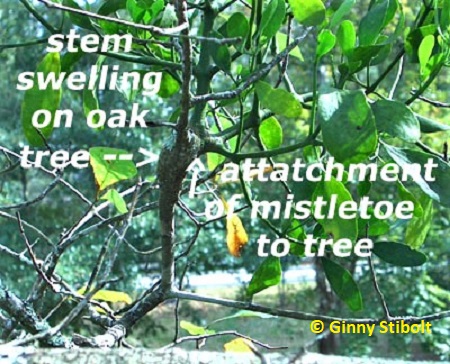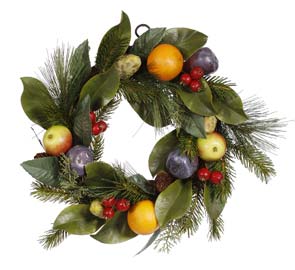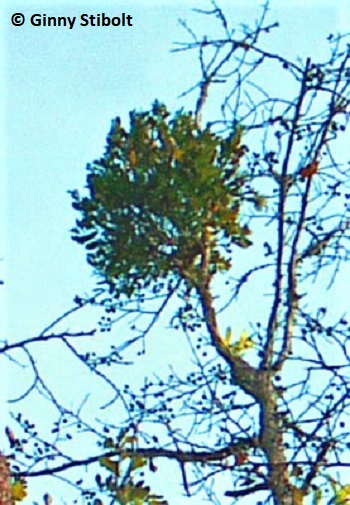Adventures of a Transplanted Gardener |
|||
Myths and history of mistletoe and magnolia
|
|||

Plant grafts from Heaven! |
You can understand how the ancients must have been mystified by mistletoe. (The European version is a different species, Viscum alba.) It lives (stays green) while the host tree apparently dies over the winter. It never touches the ground, so it must be purer somehow. Some thought that it must be a plant graft from heaven and if you look carefully in the photo I took, you can see how someone could think that. The host tree becomes swollen at the spot where the mistletoe enters it.
One of the more elaborate of the many mistletoe legends from various regions of Europe is the legend of Baldur. When the Norse god Baldur was born, his mother Frigga, the goddess of love, asked everything in the world not to harm him. Since mistletoe doesn’t grow from the ground she’d forgot to ask it not to harm her son. The mischievous god Loki figured this out, fashioned an arrow made from mistletoe, and tricked Baldur's blind brother to shoot him with the deadly arrow. Baldur came back to life in the spring, but it was because his mother prayed for his life under the mistletoe. The legend goes, if you stand under the mistletoe on the darkest days of winter, spring will come and Baldur will come back to life.
During the time of the Roman Empire, Roman soldiers would lay down their arms under the mistletoe and embrace their enemies. It’s been used for various medicinal purposes, to treat infertility and for love potions. Today we’ve merged all these stories together into the simple tradition of kissing under the mistletoe to bring you good luck. So meet me under the hemi-parasite… but don’t eat the berries because they are either poisonous, a cancer remedy or an aphrodisiac depending upon whom you ask.
Magnificent magnolias (revisited)
One of the reasons that I’ve always wanted my own southern magnolia (Magnolia grandiflora) is because I wanted to use the wonderful glossy leaves in wreaths and other holiday decorations without paying the high prices. I had in mind some of the wonderful and traditional colonial Williamsburg wreaths made with the apples and pineapples. This style is also very popular in Annapolis where I used to live. Many years ago after visiting Williamsburg to enjoy the Christmas celebrations, the simple spray on my door paled in comparison to the grand displays we’d seen there. I completely redid my door décor by adding cranberry chains, small apples, nuts and a much fancier bow.
 Very
traditional… right? Wrong. Colonists would never have put fruit on their
doors. The well-fruited door decorations we connect with the colonial
period actually started in Williamsburg in the 1930’s when the first
Christmas decoration contests were held. An article by a Williamsburg
historian states, “…with richness of color produced by the use of either
natural or artificial fruit as an embellishment. This idea was undoubtedly
suggested by the gorgeous Italian carvings and terra cottas of the Renaissance...
The magazine was referring to fifteenth-century Italian sculptor Luca
della Robbia and his progeny, the family whose name has become synonymous
with fruit and foliage swags.”
Very
traditional… right? Wrong. Colonists would never have put fruit on their
doors. The well-fruited door decorations we connect with the colonial
period actually started in Williamsburg in the 1930’s when the first
Christmas decoration contests were held. An article by a Williamsburg
historian states, “…with richness of color produced by the use of either
natural or artificial fruit as an embellishment. This idea was undoubtedly
suggested by the gorgeous Italian carvings and terra cottas of the Renaissance...
The magazine was referring to fifteenth-century Italian sculptor Luca
della Robbia and his progeny, the family whose name has become synonymous
with fruit and foliage swags.”
But the myth of colonial fruited wreaths has been passed alone so often that even one of the Midwestern university extension websites states that pomegranates and other fruits were used on wreaths during colonial times since pomegranates are one of the few fruits mentioned in the Bible. Perhaps colonists did use them for Christmas, but since they are native to the Middle East that seems unlikely. I offer this so that you may make up your own mind on the traditions. (The magnolia wreath is in the photo above is from the Williamsburg catalog and was available for purchase.)
Truly or newly traditional, magnolia leaves look wonderful as part of your door décor when complemented by apples, pineapples, pinecones, holly or other greenery. While the leathery coating will keep them looking good for some time, you may wish to spray them with wax or soak them in glycerin and water to keep them looking good for weeks.
Remember to prune well as you’re cutting off the branches to use. You should look at the overall shape of the tree and prune the branches that are too close together or ones that are sticking out at odd angles. Always prune flush with the next branch so the tree can heal itself more easily. A well-pruned magnolia will look better and will bloom more. A tree that gives pleasure in all seasons is truly magnificent. Enjoy your holiday preparations.
In my next column I’ll continue this discussion of Christmas plants and traditions with information on holly, ivy, and the Christmas pickle!
Ginny Stibolt is a life-long gardener, a botanist, a naturalist, and a garden writer. You may contact her or read more of her articles posted on her website: www.greengardeningmatters.com.
Copyright Ginny Stibolt


